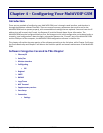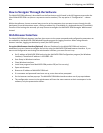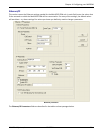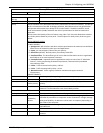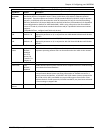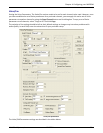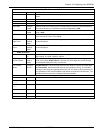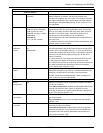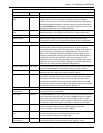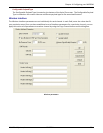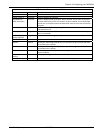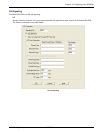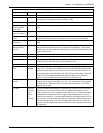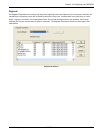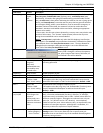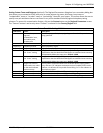
Chapter 4: Configuring your MVPGSM
Multi-Tech Systems, Inc. MVPGSM 32
Voice/Fax Parameter Definitions (continued)
Field Name Values Description
AutoCall/Offhook Alert Parameters
Auto Call / Offhook
Alert
AutoCall, The AutoCall option enables the local MultiVOIP GSM to call a remote SIP
endpoint without the user having to dial a Phone Directory Database
number. As soon as you access the local MultiVOIP GSM voice/fax channel,
the MultiVOIP GSM immediately connects to the SIP end point identified in
the Phone Number box of this option. This function requires an entry in the
Outgoing phonebook of the local MultiVOIP GSM.
Generate Local Dial
Tone
Y/N If selected, dial tone will be generated locally while the call is connecting
between gateways. This would be useful if there is a long network delay.
Offhook Alert Timer This section is grayed-out as Offhook Alert is not used.
Phone Number -- Phone number used for Auto Call function. This phone number must
correspond to an entry in the Outbound Phonebook of the local MVPGSM.
Dynamic Jitter
Dynamic Jitter Buffer Dynamic Jitter defines a minimum and a maximum jitter value for voice
communications. When receiving voice packets from an SIP end point,
varying delays between packets may occur due to network traffic problems.
This is called Jitter. To compensate, the MVPGSM uses a Dynamic Jitter
Buffer. The Jitter Buffer enables the MVPGSM to wait for delayed voice
packets by automatically adjusting the length of the Jitter Buffer between
configurable minimum and maximum values. An Optimization Factor
adjustment controls how quickly the length of the Jitter Buffer is increased
when jitter increases on the network. The length of the jitter buffer directly
affects the voice delay between MultiVOIP GSM gateways.
Minimum Jitter Value 60 - 400ms The minimum dynamic jitter buffer of 60 milliseconds is the minimum delay
that would be acceptable over a low jitter network. Default = 150 ms
Maximum Jitter Value 60 - 400ms The maximum dynamic jitter buffer of 400 milliseconds is the maximum
delay tolerable over a high jitter network. Default = 300 ms
Optimization Factor 0 - 12 The Optimization Factor determines how quickly the length of the Dynamic
Jitter Buffer is changed based on actual jitter encountered on the network.
Selecting the minimum value of 0 means low voice delay is desired, but
increases the possibility of jitter-induced voice quality problems. Selecting
the maximum value of 12 means highest voice quality under jitter conditions
is desired at the cost of increased voice delay. Default = 7.
Auto Disconnect
Automatic
Disconnection
-- The Automatic Disconnection group provides four options which can be
used singly or in any combination.
Jitter Value 1-65535 The Jitter Value defines the average inter-arrival packet deviation before the
call is automatically disconnected. The default is 300 milliseconds. A higher
value means voice transmission will be more accepting of jitter. A lower
value is less tolerant of jitter. Inactive by default. When active, default = 300
ms. However, value must equal or exceed Dynamic Minimum Jitter Value.
Call Duration 1-65535 Call Duration defines the maximum length of time (in seconds) that a call
remains connected before the call is automatically disconnected.
Inactive by default. When active, default = 180 sec.
Consecutive Packets
Lost
1-65535 Consecutive Packets Lost defines the number of consecutive packets that
are lost after which the call is automatically disconnected.
Inactive by default. When active, default = 30
Network
Disconnection
1 to 65535 Specifies how long to wait before disconnecting the call when IP network
connectivity with the remote site has been lost. Default = 30 sec



